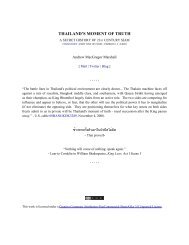THAILAND'S MOMENT OF TRUTH - ZENJOURNALIST
THAILAND'S MOMENT OF TRUTH - ZENJOURNALIST
THAILAND'S MOMENT OF TRUTH - ZENJOURNALIST
Create successful ePaper yourself
Turn your PDF publications into a flip-book with our unique Google optimized e-Paper software.
etween what is spoken and admitted privately, and what is recited and dismissed<br />
publicly is widening and exacting an increasing cost on Thai society…<br />
The messages on the wall were unprecedented and their almost-immediate removal<br />
is symptomatic of a censored society, while those who disagree with the red shirts<br />
are too afraid to ask why so many red shirts think and believe in the things they do.<br />
Denying what a substantial number of the population thinks and believes will not pull<br />
the country out of the current political impasse.<br />
A Pandora's box was opened when the coup ousted Thaksin four years ago. The least<br />
we can do now, after 91 people have died, is to start acknowledging what others feel<br />
and ask ourselves why.<br />
On October 10, 2010, the still-leaderless Red Shirts staged another mass rally at<br />
Ratchaprasong, drawing 8,000 protesters. Once again, the chant that “the bastard ordered the<br />
killing” resounded through the crowd.<br />
On October 17, a rally in Ayutthaya attracted 12,000 people. And on November 19,<br />
six months after the storming of the Red encampment, 10,000 protesters massed at<br />
Ratchaprasong once again. On January 9, a Red Shirt rally at Ratchaprasong and<br />
Ratchadamnoen following the lifting of the state of emergency attracted the biggest yet postcrackdown<br />
crowd: 60,000 people.<br />
As the mass protests gathered momentum, signs of anti-monarchist sentiment became even<br />
more apparent. An insult to Queen Sirikit was added to the anti-Bhumibol chant. A literal<br />
translation of the word used for her would be something like “cholera woman”, but a better<br />
English-language approximation is “bitch”:<br />
The bastard ordered the killing.<br />
The bitch ordered the shooting.<br />
Coded attacks on the royals were ubiquitous at Red Shirt protests: favourite T-shirts included<br />
a design bearing the image of a red ant biting a large blue whale (a reference to Sirikit’s<br />
obesity and the royal colour that represents her: Bhumibol is yellow, Sirikit blue) and another<br />
with a Thai slogan that means “I don’t know, I’m sick” (a reference to the belief among<br />
protesters that Bhumibol’s stubborn refusal to check himself out of hospital was an effort<br />
to pretend he had nothing to do with the May crackdown). Even the Thai phrase for “insert<br />
card” on ATM machines was transformed into a secret insult to King Bhumibol; a few<br />
months later, banks replaced the phrase with another using different wording.<br />
In November 2010, Nirmal Ghosh of Singapore’s Straits Times spoke to two two key Red<br />
Shirt leaders who had gone into hiding after the May crackdown. They estimated up to 90<br />
percent of the movement’s supporters were now avowedly anti-monarchy. One of them was<br />
quoted as saying:<br />
There are three realities now – the majority of the red shirts are anti-monarchy; they<br />
don’t believe in a peaceful struggle; and they need a new kind of leadership and<br />
organisation.<br />
In comments on the New Mandala blog, Thammasat professor Somsak Jeamteerasakul said<br />
he agreed with the assessment that up to 90 percent of Red Shirts were now against the<br />
monarchy.<br />
36<br />
Prior to the March rally, I wouldn’t say that anti-monarchy sentiment among the Red<br />
Shirt masses was very high. It was there; faintly, flickeringly. But now, in the past




